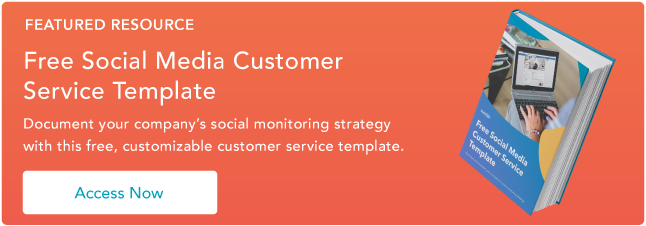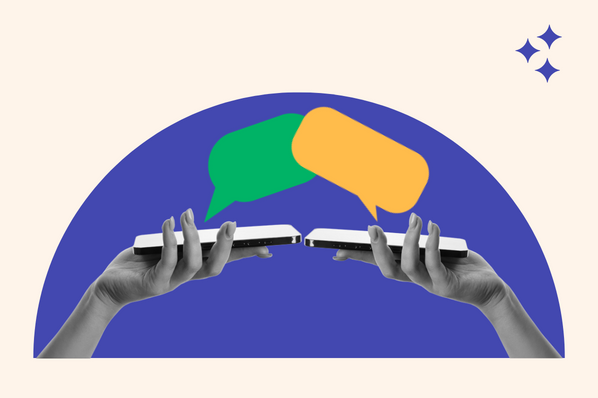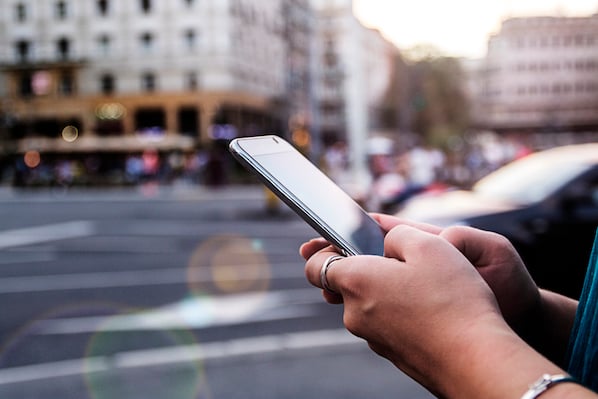With an estimated 2.9 billion users worldwide, chances are it's very likely. So it’s important to have a customer service presence to support people who are interested in your brand.
The good news is, Facebook Messenger is an excellent tool for supporting customers. It's a built-in live chat feature that connects Facebook to your CRM and help desk.
In this guide, let's walk through the pros and cons of using Facebook Messenger in a service setting. Then, we'll highlight some best practices your team should consider when using Messenger for customer service.
Pros and Cons of Facebook Messenger for Customer Service
Facebook Messenger is a real-time messaging app built into the largest social media platform in the world. It's fast, mobile, and has some great features for managing conversations.
With this in mind, let's dive into the pros and cons of Messenger in the section below.

Pros of Facebook Messenger for Customer Service
Conversational marketing is made easy.
Facebook Messenger is the perfect platform to implement conversational marketing, which is one of the most effective ways to build customer relationships. Conversational marketing also increases conversion rates and builds brand loyalty through an omnichannel experience.
Messenger can help reduce labor and software costs.
Instead of paying for live chat software, Messenger can substitute in its place for free. And, Facebook Messenger includes customizable chatbots so fewer reps are needed to manage incoming conversations.
Messenger can be integrated with most CRMs and help desks.
That way, incoming customer conversations are already recorded as support tickets, so your reps can track and monitor case progress without having to manually transfer information.
While these are all valuable benefits for your business, there are some cons to Facebook Messenger that you should be aware of.
Cons of Facebook Messenger for Customer Service
Not everyone uses Facebook.
Believe it or not, not everyone has a Facebook account. This means you might need another live chat or customer support option for that percentage of your audience. Not a huge obstacle to overcome, but for small businesses, it means managing your resources more efficiently.
Negative experiences are easy to share.
While it's great to engage customers on social media, the risk you run is that negative experiences are easy to share. If someone is unhappy about something, they're likely to make it known where everyone can see it. Even if the mishap takes place in a private chat, it's easy for customers to take a screenshot and post it to their timeline since they're already on Facebook's interface.
People expect an immediate response.
Expect to answer customers immediately. If you use email as your primary customer service channel, people will anticipate some time between responses. But, when you make yourself available on social media, people expect a much faster response.
The good news is, you don't have to reply 24/7. You can set business hours on your Facebook page and make it clear when your team will be available.
Now that we've addressed the pros and cons of Facebook Messenger, let's dive into some best practices your support team can use when providing customer service on Facebook.
Facebook and Facebook Messenger Customer Service Best Practices
You can do as much harm as good if you don't follow general social media best practices when using Facebook for customer service. Below are some core principles.
1. Respond quickly to customer inquiries.
Responding quickly to customer inquiries is vital for maximizing conversion rates. Quick responses also increase customer satisfaction and improve your brand's reputation.
But, with Facebook, speed is particularly important.
Facebook Messenger displays how quickly a business responds to messages with a color-coded badge. The highest award is a green badge displaying a lightning bolt in a speech bubble. Written next to it is the phrase "Very responsive to messages."

To obtain this, you need a response rate of at least 90% and a response time of no more than 15 minutes per inquiry over the last seven days.
This is a valuable customer acquisition and retention tool. It tells customers you're consistently on your game and will answer promptly. When a visitor is thinking about contacting your business, they can trust that they won't be put on hold or have to wait a day for a response.
2. Be friendly and professional.
Using the customer's first name has become a standard for good customer service. The same applies to you or your customer service team when they're signing a message or greeting a customer – reps should use their first name.
It's a small detail that can make a huge difference. This is particularly important when dealing with angry customers. It helps to humanize a situation as the customer is reminded they're chatting with a real person.
If a customer engages you with a public comment or post, don't forget to @ tag the person you're responding to. This will notify them you've responded, and it helps make it clear you're answering them if a conversation develops.
3. Integrate Facebook with your help desk software.
Every business can benefit from centralizing its service data. When using Messenger, take advantage of the tool by making it easier to transfer customers from your social media page to your internal ticketing system.
Instead of having a rep bounce between Twitter, Instagram, website live chat, and phone calls — all these conversations can take place in one inbox. This makes communication more seamless and avoids the hassle of signing in and out of browsers to support people on multiple channels at once.
4. Acknowledge every customer interaction.
When someone engages your business on Facebook, they expect some sort of response. Even if you just "like" their comment or thank them for dropping by, you should acknowledge every message on your timeline. If you do, you'll end up with a customer-facing message like this, telling users that you reply "instantly."

One way you can optimize this process is by using pre-written replies, or snippets. Have your team record the most common customer inquiries then create customizable responses that they can copy and paste. Just be sure to include the customer's name and personalize the message so it's specific to their inquiry. No one wants to feel like they're talking to an automated machine.
5. Train customer service reps to follow standard operating procedures.
It's also important to create guided processes for dealing with customer inquiries. These are called Standard Operating Procedures (SOPs), and your staff should follow them (most of) the time.
SOPs ensure everyone is on the same page when dealing with common customer inquiries. They guide reps through fundamental troubleshooting steps and how they should approach different types of customer interactions. This minimizes errors, improves team communication, and raises the quality and consistency of your service.
Without these procedures, a customer service rep could say something wrong or make a promise they can't fulfill. In a public conversation on Facebook, this can be very costly. Social media is not very forgiving, and negative experiences can snowball quickly if you don't have procedures in place.
It's also important to know when a conversation should be private. Sometimes customers want comments to be public, so bystanders can come to their defense if the situation turns sour. It's completely acceptable to handle these inquiries publicly unless they involve exchanging sensitive or confidential information. If they do, encourage customers to move to Messenger by explaining to them that it's for their personal security.
6. Explore using chatbots with Messenger for seamless conversations.
Using Facebook Messenger with AI chatbots is an easy way to identify customer needs or even resolve their requests entirely without requiring them to wait on a customer service rep.
When the conversation begins, the chatbot can ask general questions regarding the nature of the customer’s questions and direct them to the agent they’re looking for. This automated process is usually referred to as a chatbot strategy.
7. Leverage your self-service resources.
Facebook is a website that can support business pages in a multitude of ways besides its Messenger feature. On your business page, optimize it to provide self-service resources for potential and current customers. Here are two ideas to better utilize the site:
- Include knowledge base articles that are easy to find and access on your Facebook business page.
- Use community discussion boards to keep customers informed and engaged with the latest news of your business.
The advantage of these self-service resources is that you can lead the conversation on your social media platform where visitors won’t have to jump from channel to channel for support. The fewer the transfers — the better.
8. Go above and beyond when possible.
Average customer service is fine, but no one talks about average.
It's the few times when you "wow" a customer that really matters because these interactions are most likely to go viral.
Research shows that social media virality is closely related to positivity. The graph below highlights how happiness is the most common emotional response users have when viewing viral images.

Remember how we said it's easy for customers to share experiences with a screenshot?
There are numerous instances of exceptional customer service going viral on social media. This is one of the best kinds of marketing you can hope for, but it only comes through a consistent, dedicated effort.
Getting Started With Facebook Messenger
Facebook Messenger is an excellent customer service tool for businesses of all sizes. It's affordable, effective, and makes it easy for customers to contact your company. Not only can it be integrated with your current support systems, but it also has unique features that make it a powerful, standalone tool.
If you know your customer base is using Facebook, getting started with Messenger is a great way to reach them. Follow the best practices above and you'll create memorable customer experiences that just might be lucky enough to go viral.
Editor’s note: This post was originally published in May 2020 and has been updated for comprehensiveness.
Social Media Customer Service
.png?width=112&height=112&name=Image%20Hackathon%20%E2%80%93%20Vertical%20(61).png)



![5 Twitter Alternatives for Social Media Customer Service [& Why You Should Keep Them on Your Radar]](https://53.fs1.hubspotusercontent-na1.net/hubfs/53/twitter-alternatives.png)

![More Brands Are Using Social Media Messaging for Service, but Are Consumers Interested? [New Data]](https://53.fs1.hubspotusercontent-na1.net/hubfs/53/social%20DMs%20for%20service_featured.jpg)





